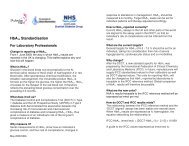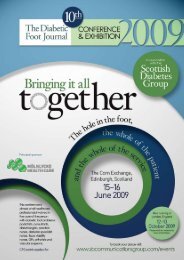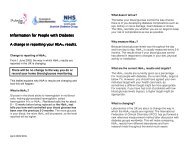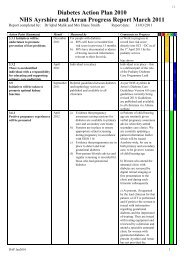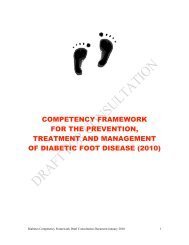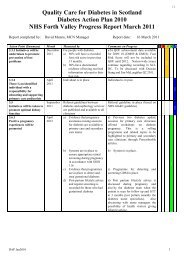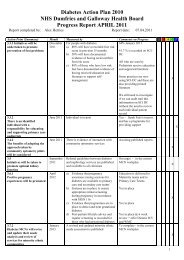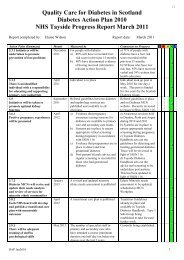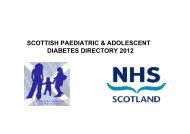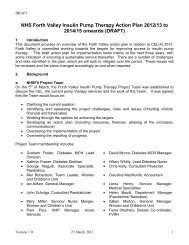DIABETES ACTION PLAN 2010
Diabetes Action Plan 2010 - Scottish Government
Diabetes Action Plan 2010 - Scottish Government
- No tags were found...
You also want an ePaper? Increase the reach of your titles
YUMPU automatically turns print PDFs into web optimized ePapers that Google loves.
<strong>DIABETES</strong> <strong>ACTION</strong> <strong>PLAN</strong> <strong>2010</strong><br />
QUALITY CARE FOR <strong>DIABETES</strong> IN SCOTLAND<br />
It is estimated that over 20,000 people 2 with diabetes remain undiagnosed in Scotland.<br />
Further action is needed to ensure that people with diabetes are identified earlier.<br />
In Scotland, screening for diabetes and non-diabetic hyperglycaemia (NDH) should be<br />
integrated into NHS Board population-based vascular screening plans. An implementation<br />
plan for vascular risk assessment in Scotland is needed and the diabetes screening element<br />
should be included in that plan. The screening strategy should include risk factor<br />
assessment and blood tests.<br />
SCOTTISH PUBLIC HEALTH NETWORK REPORT ON TYPE 2 <strong>DIABETES</strong><br />
The Scottish Public Health Network’s draft report has advised that HbA 1c be used as the<br />
preferred screening test for diabetes. This approach has been cleared by the National<br />
Screening Committee as being consistent with the vascular screening programme across<br />
the rest of the UK and with international work. The best alternative is fasting glucose.<br />
Random blood glucose is not recommended for screening for diabetes and SIGN<br />
Guideline 97 on risk estimation and prevention of cardiovascular disease should be<br />
updated accordingly. Random glucose measurement remains a satisfactory way of<br />
confirming a clinical diagnosis in a symptomatic patient.<br />
The report has also recommended that in asymptomatic individuals an HbA 1c ≥<br />
48mmol/mol (6.5%) should be repeated. A repeat level of ≥ 48mmol/mol confirms type<br />
2 diabetes mellitus. Those with an elevated HbA 1c ≥ 39mmol/mol (5.7%) but not<br />
meeting diagnostic criteria for diabetes should be classified as having non-diabetic<br />
hyperglycaemia (NDH) and should be offered intensive lifestyle intervention. In those<br />
with initial HbA 1c < 39mmol/mol screening with an HbA 1c should be repeated every five<br />
years as part of cardiovascular screening.<br />
These recommendations are under review (August <strong>2010</strong>).<br />
Methods of raising public awareness of screening programmes and the benefits of<br />
screening need to be explored. As the basis of that work, the Health Directorates should<br />
look at lessons arising from existing programmes such as the ‘Keep Well’ and ‘Well North’<br />
programmes, which relate to cardiovascular disease risk, including diabetes, using the<br />
ASSIGN risk calculator as recommended by SIGN Guideline 97. Screening for type 2<br />
diabetes also needs to link to the ‘Life Begins’ health checks, which aim to allow everyone<br />
when reaching 40 to undertake a general assessment of their health.<br />
18<br />
2 Source: Public Health Observatories/Brent/ScHARR (PBS) model and Scottish Diabetes Survey 2008.<br />
http://www.scotpho.org.uk/home/Healthwell-beinganddisease/Diabetes/Data/diabetes_undiagnosed.asp




